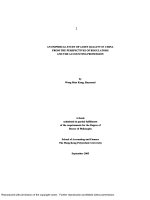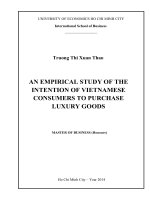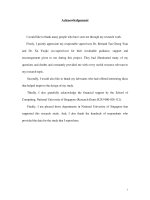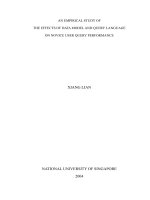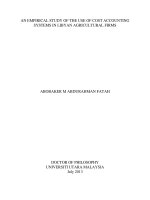Online game service satisfaction and preference an empirical study of vietnamese online gaming industry
Bạn đang xem bản rút gọn của tài liệu. Xem và tải ngay bản đầy đủ của tài liệu tại đây (2.13 MB, 112 trang )
ONLINE GAME SERVICE SATISFACTION AND PREFERENCE: AN EMPIRICAL
STUDY OF VIETNAMESE ONLINE GAMING INDUSTRY
In Partial Fulfillment of the Requirements of the Degree of
MASTER OF BUSINESS ADMINISTRATION
In International Business
By
Mr: Minh-Quan Nguyen
ID: MBA04031
International University - Vietnam National University HCMC
August 2013
ONLINE GAME SERVICE SATISFACTION AND PREFERENCE: AN EMPIRICAL
STUDY OF VIETNAMESE ONLINE GAMING INDUSTRY
In Partial Fulfillment of the Requirements of the Degree of
MASTER OF BUSINESS ADMINISTRATION
In International Business
by
Mr: Minh-Quan Nguyen
ID: MBA04031
International University - Vietnam National University HCMC
August 2013
Under the guidance and approval of the committee, and approved by all its members, this
thesis has been accepted in partial fulfillment of the requirements for the degree.
Approved:
---------------------------------------------Chairperson
--------------------------------------------Committee member
---------------------------------------------Committee member
--------------------------------------------Committee member
---------------------------------------------Committee member
--------------------------------------------Committee member
Acknowledge
I would like to thank my supervisor, Dr. Van-Phuong Nguyen - Deputy Dean, School
of Business (IU-VNU), for the patient guidance, encouragement and advice that he has
provided throughout my time as his student. I have been extremely lucky to have a supervisor
who cared so much about my work, and who responded to my questions and queries so
promptly.
Thanks to my father for the courage and everything a father could provide as support
despite the distance. My heartfelt and never-ending love to Phoenix and friends who never
kept away from me when I needed them most.
I must appreciate the VNU Central Library for being of gigantic use to me in the
process of this work.
-i-
Plagiarism Statements
I would like to declare that, apart from the acknowledged references, this thesis either
does not use language, ideas, or other original material from anyone; or has not been
previously submitted to any other educational and research programs or institutions. I fully
understand that any writings in this thesis contradicted to the above statement will
automatically lead to the rejection from the MBA program at the International University –
Vietnam National University Ho Chi Minh City.
- ii -
Copyright Statement
This copy of the thesis has been supplied on condition that anyone who consults it is
understood to recognize that its copyright rests with its author and that no quotation from the
thesis and no information derived from it may be published without the author’s prior consent.
© Minh-Quan Nguyen/ MBA04031/ 2011-2013
- iii -
Table of Contents
Chapter One - Introduction ..................................................................................................................... 1
1.1. A brief description of the research topic ...................................................................................... 1
1.2. Background .................................................................................................................................. 2
1.3. Research purpose ......................................................................................................................... 3
1.4 Research questions ........................................................................................................................ 3
Chapter Two – Literature Review ........................................................................................................... 5
2.1. Online game ................................................................................................................................. 5
2.2. Experiential value......................................................................................................................... 6
2.2.1. Utilitarian Value.................................................................................................................... 6
2.2.2. Hedonic Value ...................................................................................................................... 7
2.3. The Technology Acceptance Model (TAM) .................................................................................. 8
2.4. Transaction Cost Analysis (TCA) ................................................................................................. 10
2.4.1. Bounded rationality ............................................................................................................. 11
2.4.2. Opportunism ....................................................................................................................... 11
2.4.3. Uncertainty .......................................................................................................................... 11
2.4.4. Asset specificity .................................................................................................................. 11
2.4.5. Buying frequency ................................................................................................................ 12
2.4.6. Transaction costs ................................................................................................................. 12
2.5. Service Quality (SERVQUAL)....................................................................................................... 14
2.5.1. Tangibles: Physical facilities, equipment, and appearance of personnel. .......................... 16
2.5.2. Reliability: Ability to perform the promised service dependably and accurately. ............. 16
2.5.3. Responsiveness: Willingness to help customers and provide prompt service. .................. 16
2.5.4. Assurance: Knowledge and courtesy of employees and their ability to inspire trust and
confidence..................................................................................................................................... 16
2.5.5. Empathy: Caring, individualized attention the firm provides its customers. ..................... 16
2.6. Satisfaction and Preference: ...................................................................................................... 17
2.6.1 Satisfaction ........................................................................................................................... 17
2.6.2 Preference ............................................................................................................................ 19
Chapter III - Research Methodology .................................................................................................... 20
3.1. Theoretical framework and hypotheses ..................................................................................... 20
3.1.1. Integrated model ................................................................................................................. 20
- iv -
3.1.2. Backgrounds of online game satisfaction ........................................................................... 21
3.1.3. Online game satisfaction and preference ............................................................................ 25
3.1.4. Online game satisfaction as mediator ................................................................................. 26
3.2. Research Approach .................................................................................................................... 27
3.3. Research Design......................................................................................................................... 28
3.4. Research process ........................................................................................................................ 29
3.4.1. Pretesting............................................................................................................................. 29
3.4.2. Questionnaire design ........................................................................................................... 30
3.4.3. Sample Selection and Data Collection Procedure ............................................................... 36
3.4.4. Data Analysis Method ......................................................................................................... 37
Chapter IV – Data Analysis and findings ............................................................................................. 39
4.1. Descriptive Statistics .................................................................................................................. 39
4.2. Reliability Test ........................................................................................................................... 43
4.3. Exploratory factor analysis ........................................................................................................ 49
4.3.1. EFA of Experience value (EXP) with Satisfaction and Channel Preference ...................... 52
4.3.2. EFA of Technology Acceptance Model (TAM) with Satisfaction and Channel Preference.
...................................................................................................................................................... 52
4.3.3. EFA of Transaction Cost Analysis (TCA) with Satisfaction and Channel Preference ....... 53
4.3.4. EFA of Service Quality (SERVQUAL) with Satisfaction and Channel Preference .......... 54
4.4. Confirmatory factor analysis...................................................................................................... 60
4.5. Structural Equation Modeling (SEM) ........................................................................................ 69
4.6. Mediation ................................................................................................................................... 73
Chapter V – Discussion and conclusions .............................................................................................. 75
5.1. Interpretation of Results ............................................................................................................. 75
5.2. Practical implications ................................................................................................................. 80
5.3. Limitation and further research .................................................................................................. 81
References ............................................................................................................................................. 83
Appendix ............................................................................................................................................... 92
Appendix A. Vietnamese questionnaire............................................................................................ 92
Appendix B. Confirmatory Factor Analysis (CFA) ........................................................................ 100
Appendix C. Structural equation modeling (SEM) in AMOS ........................................................ 101
-v-
List of tables
. 1. TABLE 3.1. CODED ITEMS OF MEASUREMENT SCALE ................................................................................................... 30
. 2. TABLE 4.1.1. GENDER .......................................................................................................................................... 39
. 3. TABLE 4.1.2. AGE ................................................................................................................................................ 40
. 4. TABLE 4.1.3. EDUCATION ...................................................................................................................................... 41
. 5. TABLE 4.1.4. INCOME........................................................................................................................................... 41
. 6. TABLE 4.1.5. ...................................................................................................................................................... 42
. 7. TABLE 4.1.6. EXPERIENCE...................................................................................................................................... 42
. 8. TABLE 4.1.8. CONNECTIVITY .................................................................................................................................. 43
. 9. TABLE 4.2.1. CRONBACH'S ALPHA OF EMP .............................................................................................................. 43
. 10. TABLE 4.2.2. CRONBACH'S ALPHA OF EQU ............................................................................................................ 44
. 11. TABLE 4.2.3. CRONBACH'S ALPHA OF USE ............................................................................................................. 44
. 12. TABLE 4.2.4. CRONBACH'S ALPHA OF UT ............................................................................................................... 45
. 13. TABLE 4.2.5. CRONBACH'S ALPHA OF HD .............................................................................................................. 45
. 14. TABLE 4.2.6. CRONBACH'S ALPHA OF UNC ............................................................................................................ 45
. 15. TABLE 4.2.7. CRONBACH'S ALPHA OF ASSET ......................................................................................................... 46
. 16. TABLE 4.2.7. CRONBACH'S ALPHA OF TIME ........................................................................................................... 46
. 17. TABLE 4.2.8. CRONBACH'S ALPHA OF REL.............................................................................................................. 47
. 18. TABLE 4.2.9. CRONBACH'S ALPHA OF RESP ........................................................................................................... 47
. 19. TABLE 4.2.10. CRONBACH'S ALPHA OF ASS ........................................................................................................... 47
. 20. TABLE 4.2.11. CRONBACH'S ALPHA OF SAT ........................................................................................................... 48
. 21. TABLE 4.2.12. CRONBACH'S ALPHA OF PREF ......................................................................................................... 48
. 22. TABLE 4.3.1. EFA OF EXP................................................................................................................................... 52
. 23. TABLE 4.3.2. EFA OF TAM ................................................................................................................................. 52
. 24. TABLE 4.3.3. EFA OF TCA .................................................................................................................................. 53
. 25. TABLE 4.3.4. EFA OF SERVQUAL ....................................................................................................................... 54
. 26. TABLE 4.3.4. THE RETAINED MEASUREMENT SCALES ................................................................................................. 55
. 27. TABLE 4.4.1: CRITERIA FOR MEASUREMENT MODEL.................................................................................................. 60
. 28. TABLE 4.4.2 GOODNESS-OF-FIT INDICES OF MEASUREMENT MODEL............................................................................. 63
. 29. TABLE 4.4.3 REGRESSION WEIGHTS: (GROUP NUMBER 1 - DEFAULT MODEL) – 1ST ROUND............................................. 64
. 30. TABLE 4.4.4. REGRESSION WEIGHTS: (GROUP NUMBER 1 - DEFAULT MODEL) - 2ND ROUND........................................... 66
. 31. TABLE 4.5.2. LIST OF REJECTED HYPOTHESES ........................................................................................................... 70
. 32. TABLE 4.5.2. REGRESSION WEIGHTS: (GROUP NUMBER 1 - DEFAULT MODEL) – FINAL ROUND ......................................... 72
. 33. TABLE 4.6.1. MEDIATION ANALYSIS....................................................................................................................... 73
. 34. TABLE 5.1.1. RESULT OF HYPOTHESES .................................................................................................................... 75
- vi -
List of figures
FIGURE 1. INTEGRATED MODEL .................................................................................................................................... 26
FIGURE 2. GENDER .................................................................................................................................................... 40
FIGURE 3. SECOND-ORDER CFA ................................................................................................................................... 62
FIGURE 4. CFA OF MEASUREMENT MODEL STANDARDIZED ................................................................................................ 68
FIGURE 5. STRUCTURAL EQUATION MODELING RESULT AFTER ADJUSTING THEORETICAL MODEL ................................................ 69
FIGURE 6. INTEGRATED MODEL RESULT AFTER ADJUSTING THEORETICAL MODEL ..................................................................... 69
- vii -
Abstract
Online game’ efficiency, content and service quality has become one of the key
aspects among other factors that contribute to online game firms business growth and leading
position in the business environment with mass competition. Efficiency, content and service
also plays a significant role in service sectors since due to its untouchable nature the features
cannot be spelled out for consumers to directly make judgment before decisions are made. In
order for businesses to improve and maintain a better positioning in the competitive era, it is
necessary to evaluate the performance of the services rendered to their customers. In recent
times, online game companies spend a great deal of time and money in configuring high
efficiency, content and service to satisfy their customers. Understanding consumer-level
interaction with the online game will enhance understanding of consumer behavior, online
game design issues, and drivers of consumer satisfaction with and preference for the online
game. Customer satisfaction can be evaluated through an assessment of the quality of
efficiency, content and service delivered by the online game provider to their customers and
the level of efficiency, content and service can also be measured considering customers’
expectations and perceptions.
Purpose: This study is aimed to apply the EXP, TAM, TCA, SERVQUAL instrument
in assessing Vietnamese gamer perceptions of online game service and the level of
satisfaction obtained from the online game services rendered by the Vietnam online game
firms.
- viii -
Method: The convenience sampling technique was used to obtain data from the
chosen population to enable an evaluation of perceptions of online game satisfaction and
preference in Vietnam.
Findings and Conclusion: Firstly, with regards to the relationship between customer
satisfaction and customer preference, consistently with prior research, this analysis reconfirms that customer satisfaction is an important component positively affecting customer
preference. Secondly, experiential values do not effect to gamer satisfaction and preference,
the reason for this finding is that although online games can be entertained by gamers, the
cost of playing online game currently seem is the unsolvable problem to the online game
firms (Hsu & Lu, 2004). Thirdly, it is very interesting that Time does not effect to game
players satisfaction. That is the public concern on video game addiction rising over past
decade in Vietnam.. Hence, Vietnamese gamers do not consider Time factor as an effect
Satisfaction factor because there is a large number of Vietnamese gamers who have personal
issue with game addiction. Fourthly, the service quality (SERVQUAL) factors have
significant effects to experiential value factor could be used to approach a new rating system
on experiential value by service quality issued by online game firms. Last but not least,
assurance (ASS) has a strong positive effect to satisfaction (SAT) (1.249). Hence, this study
support strongly the face that the Vietnamese online gamers are very interested in assurance,
especially in game items trading that issued by online game producers.
Keywords: Online game, Satisfaction (SAT), Preference (PREF), Experiential Value
(EXP), Technology Acceptance Model (TAM), Transaction Cost Analysis (TCA), service
quality (SERVQUAL)
- ix -
Chapter One - Introduction
Online games or networked games are being rapidly developed with the
phenomenal growth of the Internet (Chen, Wang, & Lee, 2009). Due to deep
penetration into the consumer market, gaming is considered a prime driver of PC
technology (Hsu & Lu, 2004; Von Ahn, 2006) and currently is one of the few
profitable e-commerce applications (H.-E. Yang, Wu, & Wang, 2009). With online
gaming being a billion dollar industry and game companies making revenue from
subscription charges (Adams, 2010), the presence of gamer satisfaction and
preference issues is becoming more evident.
1.1. A brief description of the research topic
This thesis argue that there will have some factors affecting online game
service satisfaction and preference. The purpose of this study is to understand an
online game service model. This model contains several dimensions including
experiential value (H.-E. Yang et al., 2009), the Technology Acceptance Model
(TAM) (Davis, 1989), Transaction Cost Analysis (Williamson, 1987) and Service
Quality (Parasuraman, Zeithaml, & Berry, 1988), the four antecedents of online game
service satisfaction and preference and test the associations among the constructs in it.
After surveying some online game players in Ho Chi Minh City (Vietnam), this study
found that four antecedents could have significant and positive effects on online game
service satisfaction and which, in turn, significantly affect online preference.
Especially, service quality has the relatively higher total positive effects on both
online game satisfaction and preference. Meanwhile, online game satisfaction
completely mediates the effects of these antecedents on online preference. The
findings imply that how to manage online game service quality better, provide more
-1-
acceptable transaction cost, and offer more experiential value are the key ways for
effectively enhancing players’ satisfaction with the online game service in order to
retain their preference to the online game service system.
1.2. Background
The “Online Games Market in Vietnam” report provides an in-depth analysis
of the Vietnam online games market and this report forecasts the number of users
playing online games market in Vietnam to exceed 10 million by 2011, driven by
rising incomes, increasing PC and Internet penetration rates, and a large population of
youth that are actively seeking out entertainment content. These findings are
contained in the business intelligence and consulting the report “Online Games
Market in Vietnam”. There are more than 50 online games in the market; a notable
achievement given that the online games market just emerged in 2004. Other notable
trends include the emergence of locally developed titles, aimed specifically at
Vietnamese gamers.
Key findings:
+ Approximately 50% of the total Vietnamese population is under the age of
25. This is an age range that is known for being tech savvy, making them a high
priority demographic for digital entertainment companies. There are approximately 21
million Internet users in Vietnam with an Internet penetration rate of 24%.
+ In our interviews with Vietnamese gamers, many were spending 60,000 to
100,000 VND ($3 - $6) per month. In one high-end Internet café we visited, a few
interviewees were spending an average of 500,000 VND ($31) per month. These
consumers are driving the digital entertainment and online games market with virtual
item purchases. Top online games in Vietnam can attract 200,000 users. The Internet
-2-
cafes that the researchers visited in Vietnam were consistently crowded with users
playing online games.
While Vietnam has a rapidly emerging games market, critical challenges
include government regulations on online games, the worldwide slowing economy,
developing infrastructure, and low income levels.
1.3. Research purpose
Structural equation model analyses indicate that metrics tested through each
model provide a statistically significant explanation of the variation in the online
gamers' satisfaction and channel preference. There are several studies found that TAM
components—perceived ease of use and usefulness—are important in forming
consumer attitudes and satisfaction with the online game. Ease of use also was found
to be a significant determinant of satisfaction in TCA. The study tries to find
empirical support for the assurance dimension of SERVQUAL as determinant in
online game satisfaction. Further, the study also verified the general support for
consumer satisfaction as a determinant of channel preference.
Because to keep competitiveness of online game industry is hard to hard, this
study has ambition that its model can provide online game corporate to select and
adopt the key point what the online game corporate should choose and how to affect
the key factors of online game service satisfaction and online preference in online
game industry.
1.4 Research questions
The literatures revealed that the immediate factor affecting consumers to retain
preference to the providers is customer satisfaction (Devraj, Fan, & Kohli, 2002).
Similarly, in a B2C channel satisfaction model or online shopping satisfaction model,
satisfaction is considered as an important construct because it affects participants’
-3-
motivation to stay with the channel and regarded as an antecedent of repurchase
(Heilman, Bowman, & Wright, 2000). But what are the key factors that can make
them satisfied with the products and services, which, in turn, enhance their preference,
especially, in online game service environment, are still under study (Hsu & Lu, 2004;
G. Kim et al., 2013; Von Ahn, 2006).
The thesis helps us to answer four main questions:
What are the key factors that make the customer playing online game?
Why do the gamers play online game?
Do SERVQUAL, TAM, TCA and EXP influence the customer satisfaction in
online game service?
Does gamer satisfaction influence the gamer preference in online game
service?
-4-
Chapter Two – Literature Review
2.1. Online game
Online gaming has grown from a tiny fraction of the interactive entertainment
business into a major market in its own right. In this chapter, this thesis learn about
some of the features and design challenges that set online gaming apart from the more
traditional single-player or multiplayer local games (Adams, 2010). Online gaming is
a technology rather than a genre, a mechanism for connecting players together rather
than a particular pattern of gameplay (Adams, 2010; Von Ahn, 2006; H.-E. Yang et
al., 2009; X. Yang, 2013). Therefore, this thesis does not look for design
commonalities as the chapters on game genres did. Instead, it addresses some of the
design considerations peculiar to online games no matter what genre those games
belong to. It’s a huge topic, however, and there is only room in this thesis for the
highlights.
Do not confuse online gaming, as Von Ahn (2006) uses the term, with online
gambling or online casino gaming. Online gambling is a different industry, and is not
covered here. This thesis uses the term online games to refer to multiplayer distributed
games in which the players’ machines are connected by a network (Dick, Wellnitz, &
Wolf, 2005; Hsu & Lu, 2004; G. Kim et al., 2013; X. Yang, 2013). This is as opposed
to multiplayer local games in which all the players play on one machine and look at
the same screen (Adams, 2010). While online games can, in principle, include
solitaire games that happen to be provided via the Internet, such as Bejeweled, the
online aspect of solitaire games is incidental rather than essential to the experience.
Bejeweled is simply a puzzle game. Online games do not need to be distributed over
the Internet; games played over a local area network (LAN) also qualify as online
games (Adams, 2010).
-5-
2.2. Experiential value
Previous study discovered that experiential value can be created by traditional
and electronic shopping experiences (Babin, Darden, & Griffin, 1994; Hirschman &
Holbrook, 1982; Irani & Hanzaee, 2011; O’Brien, 2010). Experiential value can
indeed produce both utilitarian and hedonic value when shopping at old-style and
electronic store (Babin et al., 1994; Fiore, Kim, & Lee, 2005; Wolfinbarger & Gilly,
2001; H.-E. Yang et al., 2009).
2.2.1. Utilitarian Value
Early research on shopping value commonly emphasis on the utilitarian
feature of shopping (Bloch & Bruce, 1984). Hirschman and Holbrook (1982) have
identified that in traditional information processing shopping model, the shopper is a
rational decision creator wanting to make best use of utility by concentrating on
tangible benefits of the product. As stated in this model, acquiring has been regarded
as a problem solving action in which consumer moves through a chain of logical
stages. Especially, utilitarian shopper behavior is explained through task-related and
rational behavior (Batra & Ahtola, 1991; Kempf, 1999). Also, Hirschman (1984)
asserted that all shopping experiences involve the motivation of thoughts and
intellects. Shopping experiences viewed as a manner that provides the cognitive
(utilitarian) and affective (hedonic) benefits. More specifically, tangible attributes of
goods and services provide contribution to cognitive process and is closely related to
calculations of utilitarian value. Thus, a consumer receives utilitarian shopping value
when he or she obtains the needed product, and this value rises as the consumer
obtains the product more smoothly (Babin et al., 1994).
Perceived utilitarian shopping value might rely on whether how much of the
consumption need that prompts the shopping experience is met (Seo & Lee, 2008),
-6-
regularly, this means that the consumer purchases goods in a calculated and efficient
manner (Hirschman & Holbrook, 1982). Hence, utilitarian purchasing behavior is
more logical, rational, related to transactions (Batra & Ahtola, 1991; Seo & Lee,
2008), and related with more information gathering compared to hedonic buying
manners (Bloch & Bruce, 1984). Koufaris, Kambil, and LaBarbera (2002) suggested
that utilitarian value include time saving, control, better product information granted
by interactivity affecting attitude responses toward a product or website.
2.2.2. Hedonic Value
Bloch and Bruce (1984) defined that customers gain hedonic value as well as
utilitarian value during the shopping experience. Research about shopping has
extensive emphasize the shopping experience on the utilitarian aspects, which has
often been described as task-related and rational and linked thoroughly to whether a
product acquisition task was successfully done or not (Babin et al., 1994; Batra &
Ahtola, 1991). Nevertheless, traditional product gaining explanations may not fully
describe the entirety of the shopping experience (Bloch & Bruce, 1984). Due to this,
over the past several years have seen rising attention in the shopping experience on
the hedonic features and academics have accepted the significance of its potential
entertainment and emotional value (Babin et al., 1994). Also, hedonic value is more
particular and personal than utilitarian value. That is, customers were described as
either ‘‘problem solvers” or in terms of customers looking for ‘‘fun, fantasy, arousal,
sensory stimulation, and enjoyment” (Hirschman & Holbrook, 1982). Utilitarian value
includes shopping efficiency and making the correct product choice based on logical
valuation of product information, separately customers observe shopping as an
adventure. Moreover, the hedonic value of the consumption experience was assumed
as these forms of pleasure, hence, hedonic value was different from utilitarian value
-7-
(Hirschman, 1984). Thus, MacInnis and Price (1987) said that hedonic value can be
assumed as the emotional paybacks to the consumer perceives through the shopping
experience other than the accomplishment of the original buying intent. In a similar
context, summarized characteristics of goods and services can contribute to affective
elements in shopping and are closely related to hedonic value (Cottet, Lichtlé, &
Plichon, 2006).
Westbrook and Black (2002) recommended that shopping satisfaction contains
the opportunity for social interactions with friends, family or even strangers and the
sensual incentive such as escapes from routine life, and new information about future
styles and fashion.
Hedonic value acts both positive and negative roles in consumption regarding
consumers’ benefit. The negatively extreme form of hedonic value is impulse or
compulsive (uncontrollable) purchase. Especially, ROOKH (1987) believed impulse
buyers buy products from a need to buy rather than a need for a product. Also,
uncontrollable buyers put their values on shopping activity itself rather than a product
(Faber & O'guinn, 1992). Next, hedonic value is usually expressed by the entertaining
features of store surfing whether or not an acquisition happens (Bloch & Bruce, 1984).
2.3. The Technology Acceptance Model (TAM)
TAM, offered by Davis (1989) in his doctoral thesis, is an information system
(IS) theory that models how individuals come to accept and use a technology
(“Technology acceptance model,” n.d.). That is, TAM forecasts intention to use and
acceptance of information systems by individuals. It included perceived ease of use
(PEOU) and perceived usefulness (PU) that drive the approach toward an IS. TAM
explains why the attitude, in turn, leads to one’s intention to use an IS and how the
-8-
eventual acceptance of the IS technology is affected by system design structures
(Davis, 1993).
“Intention” in TAM represents the effect of social norms and attitudes that can
be mediated by other variables (Ajzen & Fishbein, 1980). Moore and Benbasat (1991)
claimed that if no other variables interfere, as is the case in many information
technology applications, then “intention” can be omitted. As a result, recent TAMbased studies have omitted “intention” without any loss of information (Lederer,
Maupin, Sena, & Zhuang, 2000; Straub, Limayem, & Karahanna-Evaristo, 1995;
Venkatesh, 2000). Agreeing with previous studies (Karahanna & Straub, 1999;
Venkatesh, 2000; H.-E. Yang et al., 2009), my thesis setting does not contain of a
circumstances that other variables interfered and therefore the use of “intention” is not
necessary. However, the “attitude” is believed that captured in a number of items for
channel preference. Current outcomes propose that consumer satisfaction in the online
atmosphere is considerably higher than traditional channels due to the ease of use in
gaining information (Shankar, Smith, & Rangaswamy, 2003). Ease of use can also
influence the transaction costs when the ease of use relates to information search.
Venkatesh (2000) suggests that both perceived usefulness and perceived ease
of use are found to directly influence behavioral intention to use IT, which leads to
eliminate the need for the attitude construct from the model. Perceived usefulness was
defined as “the degree to which a person believes that using a particular system would
enhance his/her job performance”, and perceived ease of use is defined as “the degree
to which a person believes that using a particular system would be free of physical
and mental effort” (Davis, 1989).
TAM is better suited to IS because it supports to understand the technology
acceptance based on ease of use and usefulness (Devraj et al., 2002). Hence, based on
-9-
recent research in IS, this thesis apply TAM concepts to observe consumer
satisfaction with the online game.
2.4. Transaction Cost Analysis (TCA)
TCA (Coase, 1937; Williamson, 1987) was firstly developed to examine the
appropriate governance structures or mechanisms for firms to conduct transactions.
TCA belonged to the “New institutional economics” (NIE), which studied the role of
governance structure in decreasing transaction cost (P. K. Rao, 2003).
A transaction happens when a good or service is shifted across a
technologically separable interface (Williamson, 1987). Classical economists
developed a theory that presumes perfect information symmetry in the efficient
market and the transaction can be executed without costs. Nonetheless, markets are
often inefficient, and this results in costs to firms in their transactions with suppliers
and customers (Coase, 1937). For example, because of the absence of information
about supplier’s completeness, a firm draft and negotiate a contract in order to defend
their interest in the transaction. In contrast, the lack of information about customers’
credit position causes the firm to search for such information (Li & 李仲文, 2008). In
an inefficient market, firms have to obtain transaction costs to safeguard a favorable
deal (Coase, 1937).
One of the priori acceptances of the TCA background is that market
governance is more efficient than hierarchical firm governance structure because of
the benefits of competition, and such acceptance is often called the production cost
advantages of the market (Coase, 1937). The TCA structure builds on the relationship
between three observable dimensions of transaction as proposed by Williamson
(1987): asset specificity, uncertainty (environmental and behavioral) and frequency,
and the two main assumptions of human behavior: bounded rationality and
- 10 -
opportunism. The interplay between these behavioral assumptions and transaction
dimensions are elaborated as follows.
2.4.1. Bounded rationality
Transactions are supposed to happen under individuals’ bounded rationality,
which implies that individuals are constrained by their basic cognitive capabilities (e.g.
limited short term memory, slow rate of information processing) to be perfectly
rational (Simon, 1955).
2.4.2. Opportunism
Excluding individual’s bounded rationality, TCA structure also proposes that
agents participate in a transaction possibly will act opportunistically if given the
chance. That is, Williamson (1985) defines opportunism as self- interest seeking
behavior concerning planned efforts to mislead and confuse exchange partners.
Opportunism ascends because buyer has imperfect control seller who has personal
interests in an exchange, and the contracts between the two parties take part in an
exchange are vague and incomplete (E. Anderson, 2008).
2.4.3. Uncertainty
The “uncertainty” is the inability to predict relevant contingencies from two
sources—unpredictable changes and information asymmetry resulting from strategic
nondisclosure or distortion of information by the sellers (Masten, Meehan, & Snyder,
1991; Williamson, 1985). Also, Devraj et al. (2002) suggested that uncertainty
reflects the extension to which good product and price information was provided
through the online channel in context of online shopping relationship.
2.4.4. Asset specificity
Opportunism poses a transactional hazard to the range that a relationship is
bordered by behavioral uncertainty, and the situation is getting worse when the
- 11 -
relationship is supported by asset specificity (Rindfleisch & Heide, 1997). Asset
specificity refers to durable investments that are undertaken in support of particular
transactions; and these specific investments represent sunk costs that have much
lower value outside of these specific transactions (Williamson, 1985). Namely, this
makes it difficult for the buyer as well as the supplier to switch. Within context of
online shopping relationship, Devraj et al. (2002) measures asset specificity by degree
of variety of product and store choices that is available through online shopping.
2.4.5. Buying frequency
Along with the two main transactional measurements previously defined, the
complete TCA outline also contains frequency as the third measurement of
transaction. The frequency dimension refers strictly to buyer activity in the market.
Recurrent transactions enable economies of scale in regard to transaction costs
because these costs will be easier to recover for numerous transactions of a recurring
kind (Williamson, 1985).
Frequency refers to the recurring nature of the transactions. But frequency has
received only limited attention in empirical TCA construct (Rindfleisch & Heide,
1997). In this thesis, the research application will focus upon the analysis based on
uncertainty and asset specificity.
2.4.6. Transaction costs
Transaction costs for retail market organizations such as online stores consist
of (1) market transaction costs for searching, bargaining, and after-sale activities and
(2) managerial transaction costs to run a store (Devraj et al., 2002). In addition, the
market transaction costs measure the efficiency level of the interactions of buyers and
sellers during a particular market setting, while the managerial transaction costs
measure the process efficiency in market organizations (Devraj et al., 2002).
- 12 -
2.4.6.1. Market transaction costs
In the context of market transaction costs, as a potential consumer seeks to
make an online acquisition, the site may offer the product image, description, price,
and feedback from other customers, in an easy-to-read format (Devraj et al., 2002; H.E. Yang et al., 2009). Also, in information system usage, S. S. Kim and Malhotra
(2005) found users’ perceived ease of use and usefulness of a website at an early
period positively affect their perceived ease of use and usefulness at a later period,
when there is no new piece of information that changes the users’ opinions. Hence,
market transaction costs basically are captured with two constructs to measure the
benefits to the market: perceived ease of use (PEOU) and time efficiency. PEOU, also
a TAM construct, measures the effort in shopping including searching, bargaining,
and after-sale monitoring. Consequently, market transaction costs are captured with
time efficiency. Time efficiency is a measure of the transaction time costs. Time
efficiency is a measure of the transaction time costs. The pioneering work of Becker
(1965) in consumer behavior suggests that the consumer maximizes his or her utility
subject to not only income constraints but also time constraints (Dellaert, Arentze,
Bierlaire, Borgers, & Timmermans, 1998). By reducing information asymmetry and
surprises, such as delivering wrong products and missing delivery dates, customers
find online shopping easy to use and less time consuming (Devraj et al., 2002).
2.4.6.2. Managerial transaction costs
In the context of the managerial transaction costs, price savings can be
considered as a measure of store efficiency because as managerial costs decrease,
savings could be passed on to consumers. In the finance literature, the transaction
costs of financial markets generally include commission fees, bid-ask spread, and
price impact costs (Berkowitz, Logue, & Noser, 1988; Devraj et al., 2002; H.-E. Yang
et al., 2009). These costs are the compensation to market makers or dealers and are
- 13 -
considered as a measure of market efficiency. As market institutions become more
efficient, the cost of trading is lowered and consumers get better prices (Devraj et al.,
2002; H.-E. Yang et al., 2009).
In conclusion, transaction costs include three dimensions: PEOU, time
efficiency and price saving. While PEOU and time efficiency are measures of the
costs between buyer and seller interactions, relative price saving is a measure of
online or conventional store transaction efficiency. Thus TCA extends TAM
constructs to the cost dimension of online transactions (Devraj et al., 2002).
2.5. Service Quality (SERVQUAL)
Parasuraman et al. (1988) recommended the most difference between service
and goods are four characteristic: intangibility, perishability, heterogeneity, and
inseparability. Therefore, the focus has different between service marketing and
products marketing. Because Parasuraman et al. (1988) indicate the fact that quality is
an “elusive and indistinct construct” commenced on an exploratory article that has
revolutionized research and given service quality a face value in a way (Ndamnsa,
2013). SERVQUAL is a mechanism used to measure quality that sprouts from this
model and works with the differences in the gaps scores derived from a questionnaire.
The SERVQUAL scale (questionnaire) has two sections; one designed to record client
expectation and the other to measure client perception in relation to a service segment
and a service firm (Parasuraman et al., 1988). The SERVQUAL model is important to
managers in service firms as it enables them to appreciate the sources of problems in
quality and how they can resolve or improve on these problems (Nair, Ranjith, Bose,
& Shri, 2010).
Moutinho and Goode (1995) assumed that the model has conquered the
service quality literature as it was founded and it is a real-world means with an
- 14 -



